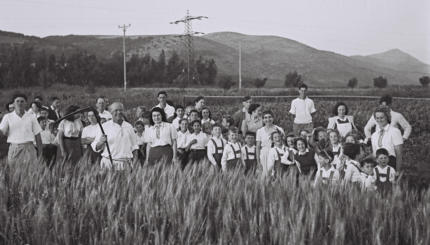I was sitting in synagogue beside a beautiful, ornate, wood carved
mechitzah
when I saw something I had never noticed before. The
Gabbai
, while checking if the congregation was done praying the
Shemonah Esrei
and if the leader should continue with the prayers, looked over to my side of the mechitzah. It was only then, as a senior in college, that I realized what I had been missing—a prayer community that acknowledges and values women’s presence.
I have never really been interested in women’s prayer groups as I feel that communal prayer is about community and mine includes all people, men and women. While I won’t argue with their validity, I also have never been a proponent of egalitarian style minyanim, prayer communities, as I am very okay with the fact that I, with a nursing baby and no
eruv
have a different
halakhic
requirement for praying with a minyan, quorum, than men do. But, I am also not okay with the fact that I am often all alone in the women’s section for the first hour and a half of synagogue services on Shabbat morning and for all of synagogue services on Shabbat afternoon.
My family normally attends a small Orthodox synagogue in Brooklyn where my husband is the rabbi. On two occasions this year, we have gone away for Shabbat. When we arrived in synagogue on Shabbat morning, the first thing my daughter asked was, “why is there no one on our side?” and then she ran to the men’s side to be with Daddy.
Orthodox Judaism, you are failing me as a mother! I have never felt like a lesser member in an Orthodox synagogue than at that moment.
How was what I did in synagogue any different than what my husband was doing? Or for that matter, what most of the men were doing? When it comes down to numbers, only about 3-8 men are up on the bima, podium, leading or visibly participating in the service for those three hours on Shabbat morning. It was not until that college Gabbai turned to check that the women were done with Shemonah Esrei that I realized that I want the synagogues in my daughter’s future to make a much more conscious effort to make her feel like an important member of the community. In our small synagogue there is no noticeable difference between the two sides of the mechitzah (as I said, we’re a small synagogue to begin with), but in all too many Orthodox synagogues the women’s section is lacking in numbers of attendees, as well as space.
My daughter was born on Tisha B’Av, which excited me because it means that she could have a truly purposeful Bat Mitzvah. Instead of reading a speech in synagogue written by her grandfather, like I did (and even that was pretty progressive), she has a variety of meaningful options. She can learn to read the Book of Eicha, Lamentations. She can make a
siyum
(celebrate the completion) on Eicha or on select
selichot
. Those projects have lasting purpose. They are transferrable skills. She could reuse her skills and read Eicha every year on Tisha B’Av.
Recently, my synagogue began a women’s megillah reading program. As I prepared to read
Shir Hashirim,
Song of Songs, on Passover, and the Book of Ruth on Shavuot, I thought about making sure that my daughter was up in the main synagogue while I read so that she could see her mommy doing “something important” in synagogue. I then realized that the point of all this is to normalize women’s participation. She should be able to miss my megillah reading sometimes, just like she sometimes misses her daddy’s Torah reading. Women’s participation shouldn’t be special, it should be normal. She should think, “Mommy and Daddy both go to synagogue and sometimes Daddy leads prayers and Mommy can read me a book, but then sometimes Mommy is busy praying and Daddy can get me water.” If my megillah reading is special, then it is not common place.
Sadly, the “normal” in today’s Orthodox synagogue is an empty or half empty women’s section until two hours into the service. As a larger community, we need to look deeper and question why this has happened and then instill policies that can ameliorate this problem.
Is the problem child care? Then let’s start children’s groups at the same time as services, or let’s be more accepting of children’s noise. Let us even go so far as to create a dark, quiet space for babies to nap.
Is the problem a lack of opportunities for women to get involved? Then let’s invite and encourage women to read the prayers for the government and for the State of Israel. Let’s pass the Torah around the entire synagogue. Let’s have two Hoshanah circles during Sukkot—one for women and one for men. Everyone should be able to dance with and celebrate the Torah!
The question that needs to be asked is: How do we make sure that everyone is valued the same whether they are male or female? How can we create Orthodox synagogues that value our daughters as important members of the community?
Gabbais should always know to check the women’s side to make sure that they are ready for the next section of prayers, and there should always be a packed house looking back.
Moved by this post? Join the conversation through MyJewishLearning’s weekly blogs newsletter.
Shabbat
Pronounced: shuh-BAHT or shah-BAHT, Origin: Hebrew, the Sabbath, from sundown Friday to sundown Saturday.
Torah
Pronunced: TORE-uh, Origin: Hebrew, the Five Books of Moses.



